Exploring the Market for Agatized Dinosaur Bones
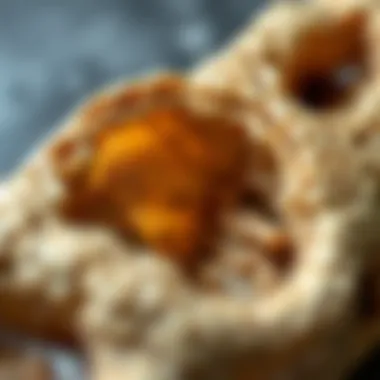
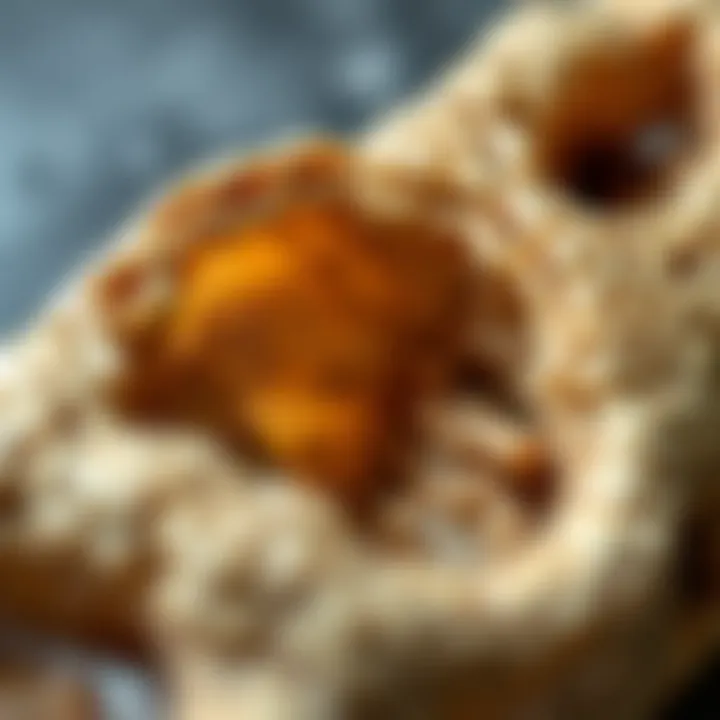
Intro
The world of fossils has always captivated the imagination of people, not just in scientific circles but also among collectors and enthusiasts. One particularly intriguing subset of fossils are agatized dinosaur bones. These ancient remnants of a long-extinct time feature striking colors and patterns, often turning out to be stunning pieces of natural art.
But what exactly is an agatized dinosaur bone? In simple terms, it is a fossilized bone that has undergone a process where the original organic material has been replaced by silica, typically in the form of agate. This transformation results in bones that are not only scientifically significant but also aesthetically appealing for collectors.
As the market for collecting this unique type of fossil expands, it becomes essential to delve into its history, classification, and the nuances of buying and selling such remarkable artifacts. Whether you’re a seasoned collector or just starting out, understanding these dimensions can provide a wealth of knowledge.
In the following sections, we will explore various aspects, from the origins and significance of agatized dinosaur bones to their market dynamics and ethical implications. Let's embark on this journey and reveal the captivating story behind these ancient treasures.
Prologue to Agatized Dinosaur Bones
The realm of agatized dinosaur bones presents a captivating intersection of history, science, and commerce. These unique fossils not only offer a glimpse into prehistoric life but also stand as tangible connections to the Earth’s distant past. The allure of these agatized bones resonates deeply with both amateur enthusiasts and seasoned collectors alike, who find themselves intrigued by the stories held within these ancient artifacts.
Defining Agatization
Agatization refers to the process whereby organic materials, such as bones, undergo mineral replacement and transformation into a form that is more durable and aesthetically appealing. In simpler terms, it’s what happens when dinosaur bones are infused with silica, leading to a striking, often colorful appearance. This transformation occurs over millions of years, as groundwater rich in dissolved silica seeps into the porous structure of the bones. With time, the organic material is replaced by these silica deposits while retaining the original shape and features of the bone.
This process not only enhances the visual attributes of the fossils but also significantly bolsters their physical durability. Collectors often find themselves enamored by the vibrant bands or opal-like sheen that characterize many agatized specimens. By understanding this process, collectors can appreciate the beauty and significance of what they’re investing in.
Historical Context of Dinosaur Fossils
Dinosaur fossils have been studied for centuries, with interests in these prehistoric giants spanning various cultures and epochs. From the earliest discoveries in the 19th century to the present-day explorations, the passion for uncovering these remnants has only intensified. Agatized bones, in particular, are rarely found in their original unaltered state, making them even more valuable and intriguing.
The fossil trade has evolved dramatically over the years, influenced by scientific advancements, changing market demands, and ethical considerations. Early fossil hunters often found and collected dinosaur bones purely for their novelty, leaving little regard for documentation or preservation. In contrast, today’s market requires a more nuanced approach, with collectors seeking not just decorative pieces but scientifically significant specimens that can deepen our understanding of paleontology.
As we navigate through the complexities of the agatized dinosaur bones market, it becomes clear that these fossils are more than mere remnants of ancient life; they are a responsibility to uphold ethical practices in collection and trade, to ensure that future generations can also marvel at these milestones in Earth’s history.
Understanding Agatization Process
The journey through the world of agatized dinosaur bones isn’t complete without a solid grasp of the agatization process. This understanding is pivotal as it sets the foundation for recognizing why such fossils are not only rare treasures but also significant artifacts of natural history. The process involves intricate changes that occur during fossilization, creating stunning specimens sought after by collectors and researchers alike.
The Role of Silica in Fossilization
To begin with, silica is the star player in the agatization story. When a dinosaur bone is subjected to the masterful hands of time, silica, often from volcanic ash or mineral-laden groundwater, seeps into the porous structure of the bone. Now, one might wonder, why is this element so crucial? Silica crystallizes over time, replacing the original organic materials and effectively turning the once fragile bone into a durable, agatized mineral.
• Durability: Agatized bones are not just robust; they become remarkably resilient, ensuring that the intricate details of the bone's structure can be preserved for millions of years. • Varied Colors: The presence of different minerals in the silica solution lends itself to a spectrum of vibrant hues, making each agatized bone unique and often visually compelling. • Paleoenvironment Insight: By studying the specific silica composition, paleontologists can glean valuable insights into the environment in which the dinosaur lived and died, linking specific silica signatures to terrains now long gone.
Environmental Conditions Favoring Agatization
Shifting gears, let’s talk about the environmental conditions that can influence whether a fossil undergoes the agatization process. Several factors come into play. Here are some key aspects that favor agatization:
- pH Levels: The acidic or alkaline nature of the surrounding environment significantly affects silica solubility. A balanced pH is optimal for the dissemination of those critical silica minerals.
- Water Quality: Freshwater sources can contribute differently to the mineralization process compared to saltwater, influencing the rate at which silica permeates the bones.
- Temperature: Warm environments generally accelerate the chemical reactions associated with mineralization. Consequently, locations with stable temperatures are more likely to favor the process.
- Sedimentary Context: The type of sediment surrounding the bones plays a role as well. Fine-grained sediments facilitate better preservation conditions, often leading to higher probabilities of agatization.
"Understanding the conditions for agatization not only enriches knowledge; it lays the groundwork for ensuring successful collection and appreciation of these natural wonders."
In summary, the process of agatization, driven primarily by the role of silica and favorable environmental conditions, transforms organic remains into mineralized forms that tell us stories from a time long past. For collectors, a deeper insight into these processes can enhance the value and appreciation of their agatized dinosaur bone specimens, underscoring their unique place in the market.
Characteristics of Agatized Dinosaur Bones
When it comes to agtized dinosaur bones, appreciating their characteristics is crucial for collectors and enthusiasts alike. These unique fossils, formed over millions of years through a complex process involving silica replacement, showcase remarkable visual and physical traits that distinguish them from ordinary fossils. Understanding these elements helps potential buyers make informed decisions, ensuring that their collection not only gains value but also enriches their knowledge of prehistoric life.
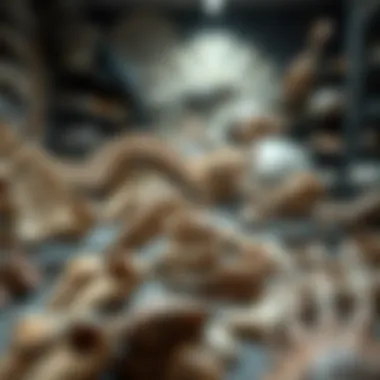
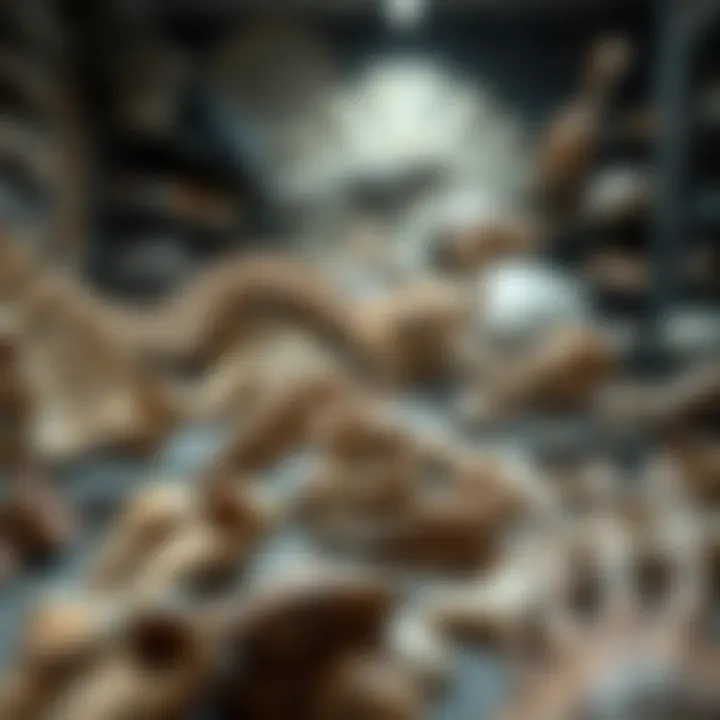
Visual Features to Identify
Identifying the visual features of agatized dinosaur bones can be an exhilarating experience for collectors. The colors often blend stunningly, ranging from earthy browns to vibrant greens and deep reds. This marbling effect is a direct result of the mineral content during the agatization process.
- Texture: Look for a smooth, glass-like surface, often with a waxy sheen. The brilliance of these surfaces can mesmerize even seasoned collectors.
- Patterns: Each piece may exhibit its own unique patterns, resembling the intricate designs found in natural stones. Swirls and bands are not mere aesthetics; they can offer insights into the geological history of the specimen.
- Cross-Section Views: If you can access polished cross-sections, they might reveal an array of layers, each telling its own story of the fossil’s formation.
These visual features are not just for show; they can often indicate the fossil’s age and the conditions under which it formed.
Physical Properties and Durability
The physical properties of agatized dinosaur bones play a significant role in their desirability. Unlike organic dinosaur bones, which can be fragile and susceptible to decay, agatized specimens possess impressive durability.
- Hardness: Many agatized bones are comparable to quartz on the Mohs scale, making them resistant to scratches and wear.
- Weight: They tend to be heavier than regular fossils due to the mineral content, providing a tangible sense of their preservation.
- Weather Resistance: Their resistance to weathering makes them an excellent choice for outdoor displays or exhibitions, allowing collectors to showcase their treasures without fear of degradation.
In essence, these properties assure that an investment in agatized dinosaur bones is not just an aesthetic choice, but a practical one.
Scientific Significance in Paleontology
Agatized dinosaur bones hold unique value in the field of paleontology. Each specimen serves not just as a decorative piece, but as a record of Earth’s prehistoric legacy.
Researchers study these fossils to gain insights into a bygone era, focusing on:
- Evolutionary Insights: These fossils provide critical data regarding the adaptive changes in dinosaur species over millions of years.
- Environmental Reconstructions: Analyzing the mineral content and isotopic compositions can help elucidate the ancient environments these creatures lived in.
- Digging Deeper into Geology: The agatization gives clues about the geological events that shaped the landscape where the dinosaurs once walked, offering a rich tapestry of history.
"Not all fossils are created equal; the stories behind agatized bones often tell us far more than just the existence of dinosaurs."
Market Overview of Agatized Dinosaur Bones
Understanding the market for agatized dinosaur bones is crucial for anyone interested in this unique field of collectibles. The appeal of these fossils, with their entrancing colors and intricate patterns, goes beyond mere aesthetics. Collectors are drawn not just to their beauty but also to their scientific significance. In this section, we will examine current trends in demand and how these influence market prices, giving a more comprehensive view of what drives the trading of these ancient relics.
Current Trends and Demand
The demand for agatized dinosaur bones has shown distinct trends in recent years. As fossil collectors seek unique pieces, the popularity of these agatized specimens has surged dramatically. What does this mean, practically?
- Increased Visibility: Social media platforms, and online forums have created a lively marketplace where sellers and buyers converge. This digital visibility often drives both interest and prices upwards. Enthusiasts are now more connected than ever, sharing photos and experiences, thus enhancing the allure of collecting.
- Educational Use: More museums and educational institutions are looking for agatized specimens for displays. This professional interest supports a robust secondary market. People are keen to own a piece of history that also serves as an educational tool.
- Shift Toward Sustainability: Modern collectors are becoming increasingly aware of the ethical implications surrounding fossil collection. Many are prioritizing sustainability in their purchases, seeking out dealers who demonstrate responsible practices.
"Collectors today are not just about owning; they care about the story that comes with the bones—where they’ve been, how they were obtained."
Setting Market Prices
Establishing the value of agatized dinosaur bones is not a straightforward process. Several factors come into play that can significantly influence pricing in this market. Here’s a look at key elements affecting how prices are set.
- Rarity and Quality: The uniqueness of each specimen heavily influences its price. Agatized bones that feature striking colors and patterns fetch higher prices. Likewise, the size of the bone impacts value, with larger pieces often sold at premium rates.
- Provenance: A well-documented history of the specimen can add value. If the bone’s origins are traceable and it comes from a reputable finding site, its price can increase substantially. Collectors love a good backstory.
- Market Fluctuations: Like any collectible market, prices can fluctuate based on current trends and the economic landscape. During times of economic prosperity, people tend to spend more on luxury items. Conversely, during downturns, prices may drop as disposable income shrinks.
- Authentication and Certification: Specimens that come with a certificate of authenticity from recognized authorities command higher prices. Buyers often want assurance that what they are investing in is genuine, especially in a niche market so ripe for counterfeit products.
Finding Agatized Dinosaur Bones for Sale
When it comes to adding an extraordinary piece to your fossil collection, locating agatized dinosaur bones for sale holds significant importance. This process isn't just about availability; it encompasses understanding the factors that inform the purchasing journey. The right acquisition can yield not only aesthetic pleasure but also historical value. In this section, we will delve into how collectors can find these unique specimens, ensuring that their efforts yield genuine and captivating pieces.
Reputable Online Dealers
In today's digital age, online dealers have emerged as key players in the market for agatized dinosaur bones. Shopping online offers convenience, wider options, and access to dealers beyond geographical boundaries. However, it is crucial to approach this channel with a discerning eye to avoid pitfalls. Here are some essential factors to consider when vetting online dealers:
- Check for Reviews: Previous customers often leave feedback regarding their experiences. Look for testimonials that indicate a dealer’s reliability and integrity.
- Professional Websites: A well-designed site with detailed descriptions of pieces indicates a serious dealer. You should find pictures from different angles, showing off the fine detail of the agatized bones.
- Authentication Guarantees: Dealers should offer certifications or guarantees proving the authenticity of their fossils. This fosters trust in your investment.
- Return Policy: Understanding the return policy is crucial. Credible dealers will provide clear terms if the item does not meet your expectations.
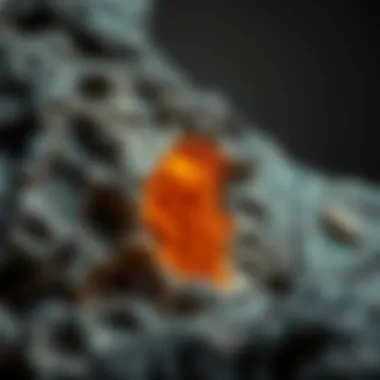
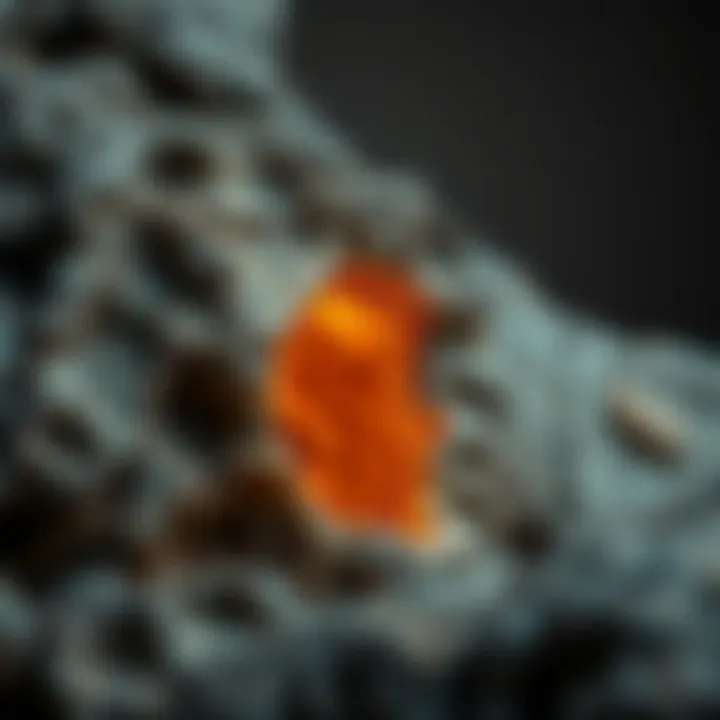
While browsing, take the time to compare various listings. Some platforms include The Fossil Forum or eBay, where reputable sellers showcase their collections. Regularly checking these channels may lead to finding the rare pieces you’re after.
Auction Houses and Collectible Shows
Exploring auction houses and collectible shows can also be an excellent approach to find agatized dinosaur bones. These venues not only provide a platform for direct interaction with sellers but also enhance the overall experience of fossil hunting. Here are some notable aspects to consider:
- Atmosphere of Expertise: Auctions and shows typically attract experienced collectors and dealers, allowing you the chance to gain insights and advice while browsing.
- Potential for Competitive Prices: Bidding at auctions can sometimes yield great bargains. If you carefully designate your budget and remain strategic, opportunities may arise to acquire pieces below retail prices.
- In-Person Verification: One big advantage of shopping at shows is the ability to examine items closely. You can assess the quality and characteristics of the fossils firsthand, leading to more informed decisions.
- Networking Opportunities: These events foster relationships within the fossil community. Engaging with others can lead to referrals or insider tips on future deals.
Evaluating Authenticity
Evaluating the authenticity of agatized dinosaur bones is a critical topic that deserves thorough exploration. As these fossils attract an increasing number of collectors and enthusiasts, the potential for imitation or misrepresentation in the market also rises. Understanding how to discern genuine agatized specimens from fraudulent ones not only protects your investment but also plays a significant role in maintaining the integrity of the fossil collection community.
When it comes to agatized dinosaur bones, authenticity verification hinges on several factors, including provenance, material analysis, and visual inspection. Tools and methods for authentication are essential parts of this process. Authentic specimens can offer both scientific and monetary value, whereas replicas or altered fossils may dilute their significance and potentially mislead collectors.
Tips for Verification
To ensure the authenticity of an agatized dinosaur bone, prospective buyers should consider the following tips for verification:
- Research Provenance: Request information about the fossil’s history. Knowing where the bone was sourced and how it ended up in the market can reveal significant details about its legitimacy.
- Inspect Visual Features: Look closely at the surface texture and coloration. Authentic agatized bones typically exhibit a distinct crystalline pattern due to the silica that replaces original organic materials.
- Conduct Material Testing: If possible, utilize scientific tests like X-ray diffraction or Raman spectroscopy to analyze the silica content. Authentic agatized fossils are rich in minerals that give them their characteristic appearance.
- Consult Experts: Don’t hesitate to seek feedback from paleontologists or reputable fossil appraisers. Their experience can uncover potential red flags you might overlook.
Role of Certification
Certification serves as a critical factor in establishing and reinforcing the authenticity of agatized dinosaur bones. By providing a documented verification from a recognized authority, collectors can gain confidence in their purchases. Here are several points highlighting the role of certification in this niche market:
- Third-party Validation: Independent certification bodies assess and verify specimens based on specific criteria, including geological analysis and fossil characteristics. This adds a layer of trust and value to a collection.
- Market Differentiation: Certified agatized dinosaur bones typically retain a higher market value than their uncertified counterparts. Collectors are generally more willing to invest in pieces that come with assurances of legitimacy.
- Educational Resources: Certificates often include detailed information about the findings, which can educate collectors on the significance of their specimens and the process of agatization.
- Evolving Standards: The certification process will often evolve with advances in technology and methodologies in fossil studies. Engaging with certifying bodies helps the community stay updated and adhere to best practices.
"In the world of paleontology, verification not only safeguards your investments but also contributes to the collective knowledge and ethical standards within the fossil trade."
In summary, verifying the authenticity of agatized dinosaur bones is essential for anyone looking to purchase these remarkable artifacts. Effective verification tips and the crucial role of certification can empower collectors with the knowledge required to make informed decisions in a complex market.
Caring for Agatized Dinosaur Bones
Caring for agatized dinosaur bones is not just a matter of pride for collectors; it's about preserving pieces of history that embody millions of years of evolution. These unique fossils deserve special attention to ensure they remain in prime condition. Effective care can significantly enhance their aesthetic appeal and resale value. Let's explore necessary practices that maximize longevity and safeguard these treasures.
Storage Recommendations
Proper storage of agatized dinosaur bones is crucial. The right environment can prevent damage and deterioration. Here are some key guidelines to consider:
- Temperature Control: Keep your fossils in a stable, cool environment. Excessive heat or extreme cold can cause cracking or expansion.
- Humidity Levels: High humidity can lead to mold growth, while low humidity can dry out the specimen. Ideally, aim for a relative humidity of around 40% to 60%.
- UV Protection: Ultraviolet light can fade colors and degrade materials. Store your fossils in a dark place or use UV-filtering glass if displaying them.
- Avoid Direct Contact: Always handle fossils with clean hands or use cotton gloves. Oils and dirt from your fingers can cause damage over time.
- Use Appropriate Displays: Utilize padded boxes or display cases. Each fossil should have adequate cushioning to prevent movement, which could cause chipping or breakage.
Cleaning Techniques
Keeping agatized dinosaur bones clean is essential for both aesthetics and preservation. Here are some safe methods:
- Dry Brushing: Begin with a soft-bristled brush to remove loose dirt. This method is effective and avoids any moisture that could harm the bone.
- Damp Cloth Wipe: For more stubborn grime, lightly dampen a microfiber cloth with distilled water. Avoid soaking the cloth; excess moisture can cause problems.
- Avoid Harsh Chemicals: Do not use chemical cleaners. They can react negatively with the materials in agatized bones. Stick with simple, non-abrasive cleaners.
- Consult Professionals: For significant cleaning needs or damage, consider seeking help from a professional conservator. They have the expertise to clean without risking harm to your fossils.
"A well-cared-for fossil isn’t just a display piece; it’s a connection to the Earth’s past – treat it right and it’ll serve you well."
Ethical Considerations in Fossil Collection
In the realm of agtized dinosaur bones, ethical conderations play a crucial role. Collecting fossils can sometimes tread into murky waters, where the lines of legality and morality become blurred. The fascination with these ancient relics often drives collectors to seek specimens without considering the broader implications of their actions.
When it comes to ethical fossil trade, awareness and responsibility are paramount. Engaging in fossil collection should go hand-in-hand with a commitment to preserving history and supporting sustainable practices.


Legal Implications in Fossil Trade
The legal landscape surrounding fossil trade is intricate and varies by jurisdiction. Many countries enforce strict regulations regarding the collection, sale, and export of fossils, including agatized bones. For instance, in the United States, the Federal Fossil Preservation Act serves to protect fossils found on federal land. Collectors must navigate these laws to avoid legal repercussions.
Importantly, acquiring fossils through illegal means not only undermines the integrity of paleontological science but also diminishes the value of legitimate collections.
"Buying, selling, or collecting fossils irresponsibly can lead to significant ecological and legal consequences."
Fossil dealers and collectors are urged to ensure any acquisition complies with local laws—obtaining necessary permits when collecting on public lands, for instance. Moreover, enthusiasts should verify the legality of their purchases. Reputable dealers should willingly provide documentation that indicates the provenance of fossils, thereby ensuring compliance with all applicable laws.
Supporting Conservation Efforts
As the interest in agtized dinosaur bones surges, the importance of conservation efforts becomes increasingly evident. Supporting scientific research and conservation initiatives not only enhances understanding of these remarkable specimens but also contributes to the preservation of valuable paleontological sites. Many institutions and organizations, such as the Society of Vertebrate Paleontology or various local museums, work tirelessly to protect and study dinosaur fossils. Contributions to these organizations can have a meaningful impact on fossil preservation.
Additionally, by engaging in responsible collecting practices, enthusiasts can help mitigate the negative effects of fossil poaching. When collectors prioritize ethical sourcing, they reinforce the message that such practices are vital for the sustainability of fossil resources. Through education and awareness, they can also influence others in the community to act accordingly.
Future of Agatized Dinosaur Bones
The future of agatized dinosaur bones holds a promise that is as intriguing as the fossils themselves. The field of paleontology, particularly in relation to agatized specimens, is not static; it evolves with scientific breakthroughs and technological improvements. As awareness grows about these remarkable artifacts, collectors, researchers, and institutions are paying closer attention to how they can be authenticated, preserved, and enriched through scientific inquiry.
Advancements in Fossil Research
Researchers are continually making strides in understanding the processes surrounding fossilization, with a keen eye on agatization. This area of study not only enhances our knowledge of prehistoric life but also informs current practices in fossil collection and preservation. For instance, recent studies using isotopic analysis offer insights about the environmental conditions that facilitate the silicate mineralization process, which is crucial to agatization. Moreover, there's an increase in interdisciplinary approaches, blending geology, chemistry, and biology, leading to highly nuanced understandings of these specimens.
- New Techniques: Innovative methods, like X-ray computed tomography, provide non-destructive ways to view internal structures of fossils, allowing researchers to analyze agatization without damaging the specimen. This is particularly beneficial when dealing with rare finds that may be the only representatives of certain species.
- Research Collaborations: Academic institutions and fossil collectors are teaming up more than ever to share knowledge. This synergy is evident in conferences and symposiums that focus on new research findings and ongoing fossil discoveries, creating a platform for exchanging ideas and resources.
Impact of Technology on Fossil Authentication
The advancement of technology is revolutionizing how collectors and researchers authenticate agatized dinosaur bones. Authenticity can make or break a sale in the market, making it crucial for buyers and sellers alike to rely on robust verification processes.
- Digital Authentication Tools: A variety of software applications now enable collectors to analyze the physical properties and isotopic composition of fossils. These tools assist in determining if a bone is genuinely agatized and if it has been subjected to modern modification or restoration, allowing collectors to make educated purchasing choices.
- Blockchain for Provenance Tracking: Some forward-thinking collectors and dealers are exploring how blockchain technology could enhance transparency in transactions. By recording the provenance of each piece, potential buyers can access a secure database that documents the history and authenticity of the fossils.
The future of agatized dinosaur bones, rooted in scientific advancement and technological integration, seems bright. As research continues and technology continues to improve, the collective community can anticipate enhanced understanding and respect for these extraordinary remnants of the distant past. The goal should not only be to collect but to appreciate and contribute to an ongoing dialogue regarding these captivating geological phenomena.
"Understanding the past can better prepare us for the future. Every agatized bone tells a story not just of its own history, but of our planet’s journey." – A leading paleontologist
As engagement increases around these conscious collecting practices, the community moves toward ensuring sustainable acquisition of scientific artifacts, reflecting a maturing market that balances passion and purpose.
Ending
As we wrap up this exploration into the world of agatized dinosaur bones, the significance of our findings comes into sharp focus. This journey not only uncovers how these fossils form and what makes them unique, but also illuminates the intricate market that surrounds them. Understanding the elements that contribute to the allure of agatized bones can enhance one’s appreciation for paleontology and fossil collecting as a whole.
Summary of Insights
Throughout this article, we've delved into various aspects of agatized dinosaur bones, highlighting key points such as:
- The scientific processes involved in their formation, notably the role of silica.
- The distinct visual features that set agatized fossils apart from their traditional counterparts, revealing their captivating colors and patterns.
- Current market trends that indicate a growing demand among collectors, as well as factors influencing market pricing.
- The importance of authentication and ethical considerations when it comes to fossil collection.
These insights are essential for both newcomers and seasoned collectors in the fossil market. They pave the way for a deeper understanding and greater respect for these treasures of our natural history.
Encouragement for Responsible Collecting
It is crucial to approach the collection of agatized dinosaur bones with a sense of responsibility. Fossil collecting not only provides opportunities for individuals to connect with history, but it also carries a weight of stewardship over these irreplaceable artifacts. Respectful practices in acquisition and preservation ensure that future generations can marvel at the wonders of our planet’s ancient life.
Key principles for responsible collecting include:
- Always verify the legitimacy and provenance of fossils. Ensure sellers are reputable and that each specimen has a documented history.
- Support conservation efforts, which may include funding for research or donating to institutes focused on paleontological studies.
- Participate in discussions within the fossil collecting community, sharing insights and promoting ethical standards.
In closing, embarking on the journey of collecting agatized dinosaur bones is as much about personal enjoyment as it is about contributing positively to the broader scientific community. By following ethical guidelines and staying informed, collectors can preserve the integrity of this fascinating field.



